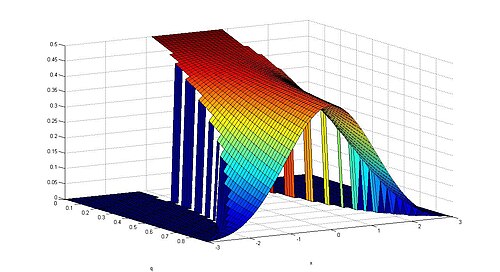Family of probability distributions
This article is about the distribution introduced by Diaz and Teruel. For the Tsallis q-Gaussian, see q-Gaussian .
In mathematical physics and probability and statistics , the Gaussian q -distribution is a family of probability distributions that includes, as limiting cases , the uniform distribution and the normal (Gaussian) distribution . It was introduced by Diaz and Teruel. It is a q-analog of the Gaussian or normal distribution .
The distribution is symmetric about zero and is bounded, except for the limiting case of the normal distribution. The limiting uniform distribution is on the range -1 to +1.
Definition
The Gaussian q-density. Let q be a real number in the interval [0, 1). The probability density function of the Gaussian q -distribution is given by
s
q
(
x
)
=
{
0
if
x
<
−
ν
1
c
(
q
)
E
q
2
−
q
2
x
2
[
2
]
q
if
−
ν
≤
x
≤
ν
0
if
x
>
ν
.
{\displaystyle s_{q}(x)={\begin{cases}0&{\text{if }}x<-\nu \\{\frac {1}{c(q)}}E_{q^{2}}^{\frac {-q^{2}x^{2}}{_{q}}}&{\text{if }}-\nu \leq x\leq \nu \\0&{\mbox{if }}x>\nu .\end{cases}}}
where
ν
=
ν
(
q
)
=
1
1
−
q
,
{\displaystyle \nu =\nu (q)={\frac {1}{\sqrt {1-q}}},}
c
(
q
)
=
2
(
1
−
q
)
1
/
2
∑
m
=
0
∞
(
−
1
)
m
q
m
(
m
+
1
)
(
1
−
q
2
m
+
1
)
(
1
−
q
2
)
q
2
m
.
{\displaystyle c(q)=2(1-q)^{1/2}\sum _{m=0}^{\infty }{\frac {(-1)^{m}q^{m(m+1)}}{(1-q^{2m+1})(1-q^{2})_{q^{2}}^{m}}}.}
The q -analogue q
t
{\displaystyle t}
[
t
]
q
=
q
t
−
1
q
−
1
.
{\displaystyle _{q}={\frac {q^{t}-1}{q-1}}.}
The q -analogue of the exponential function is the q-exponential , E q
E
q
x
=
∑
j
=
0
∞
q
j
(
j
−
1
)
/
2
x
j
[
j
]
!
{\displaystyle E_{q}^{x}=\sum _{j=0}^{\infty }q^{j(j-1)/2}{\frac {x^{j}}{!}}}
where the q -analogue of the factorial is the q-factorial , q
[
n
]
q
!
=
[
n
]
q
[
n
−
1
]
q
⋯
[
2
]
q
{\displaystyle _{q}!=_{q}_{q}\cdots _{q}\,}
for an integer n > 2 and q q
The Cumulative Gaussian q-distribution. The cumulative distribution function of the Gaussian q -distribution is given by
G
q
(
x
)
=
{
0
if
x
<
−
ν
1
c
(
q
)
∫
−
ν
x
E
q
2
−
q
2
t
2
/
[
2
]
d
q
t
if
−
ν
≤
x
≤
ν
1
if
x
>
ν
{\displaystyle G_{q}(x)={\begin{cases}0&{\text{if }}x<-\nu \\\displaystyle {\frac {1}{c(q)}}\int _{-\nu }^{x}E_{q^{2}}^{-q^{2}t^{2}/}\,d_{q}t&{\text{if }}-\nu \leq x\leq \nu \\1&{\text{if }}x>\nu \end{cases}}}
where the integration symbol denotes the Jackson integral .
The function G q
G
q
(
x
)
=
{
0
if
x
<
−
ν
,
1
2
+
1
−
q
c
(
q
)
∑
n
=
0
∞
q
n
(
n
+
1
)
(
q
−
1
)
n
(
1
−
q
2
n
+
1
)
(
1
−
q
2
)
q
2
n
x
2
n
+
1
if
−
ν
≤
x
≤
ν
1
if
x
>
ν
{\displaystyle G_{q}(x)={\begin{cases}0&{\text{if }}x<-\nu ,\\\displaystyle {\frac {1}{2}}+{\frac {1-q}{c(q)}}\sum _{n=0}^{\infty }{\frac {q^{n(n+1)}(q-1)^{n}}{(1-q^{2n+1})(1-q^{2})_{q^{2}}^{n}}}x^{2n+1}&{\text{if }}-\nu \leq x\leq \nu \\1&{\text{if}}\ x>\nu \end{cases}}}
where
(
a
+
b
)
q
n
=
∏
i
=
0
n
−
1
(
a
+
q
i
b
)
.
{\displaystyle (a+b)_{q}^{n}=\prod _{i=0}^{n-1}(a+q^{i}b).}
Moments
The moments of the Gaussian q -distribution are given by
1
c
(
q
)
∫
−
ν
ν
E
q
2
−
q
2
x
2
/
[
2
]
x
2
n
d
q
x
=
[
2
n
−
1
]
!
!
,
{\displaystyle {\frac {1}{c(q)}}\int _{-\nu }^{\nu }E_{q^{2}}^{-q^{2}x^{2}/}\,x^{2n}\,d_{q}x=!!,}
1
c
(
q
)
∫
−
ν
ν
E
q
2
−
q
2
x
2
/
[
2
]
x
2
n
+
1
d
q
x
=
0
,
{\displaystyle {\frac {1}{c(q)}}\int _{-\nu }^{\nu }E_{q^{2}}^{-q^{2}x^{2}/}\,x^{2n+1}\,d_{q}x=0,}
where the symbol !! is the q -analogue of the double factorial given by
[
2
n
−
1
]
[
2
n
−
3
]
⋯
[
1
]
=
[
2
n
−
1
]
!
!
.
{\displaystyle \cdots =!!.\,}
See also
References
Díaz, R.; Pariguan, E. (2009). "On the Gaussian q-distribution". Journal of Mathematical Analysis and Applications 358 : 1–9. arXiv :0807.1918 . doi :10.1016/j.jmaa.2009.04.046 . S2CID 115175228 . Diaz, R.; Teruel, C. (2005). "q,k-Generalized Gamma and Beta Functions" (PDF). Journal of Nonlinear Mathematical Physics 12 (1): 118–134. arXiv :math/0405402 . Bibcode :2005JNMP...12..118D . doi :10.2991/jnmp.2005.12.1.10 . S2CID 73643153 . van Leeuwen, H.; Maassen, H. (1995). "A q deformation of the Gauss distribution" (PDF). Journal of Mathematical Physics 36 (9): 4743. Bibcode :1995JMP....36.4743V . CiteSeerX 10.1.1.24.6957 . doi :10.1063/1.530917 . hdl :2066/141604 . S2CID 13934946 . Exton, H. (1983), q-Hypergeometric Functions and Applications , New York: Halstead Press, Chichester: Ellis Horwood, 1983, ISBN 0853124914 , ISBN 0470274530 , ISBN 978-0470274538
Categories :
Text is available under the Creative Commons Attribution-ShareAlike License. Additional terms may apply.
**DISCLAIMER** We are not affiliated with Wikipedia, and Cloudflare.
The information presented on this site is for general informational purposes only and does not constitute medical advice.
You should always have a personal consultation with a healthcare professional before making changes to your diet, medication, or exercise routine.
AI helps with the correspondence in our chat.
We participate in an affiliate program. If you buy something through a link, we may earn a commission 💕
↑





 is given by
is given by








